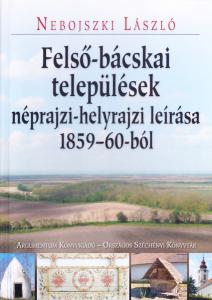
Ethnographical and topographical description of Upper-Bácska settlements from 1859–60
Felső-bácskai települések néprajzi-helyrajzi leírása 1859–60-ból (Ethnographical and topographical description of Upper-Bácska settlements from 1859–60)
Written by László Nebojszki
NSZL – Argumentum Publishing House, Budapest, 2017, 808+26 pages
ISBN 978 963 446 793 9
Count Johann Coronini-Cronberg, the military and civil governor of the Serbian Vojvodina and Banat of Temes, ordered the local and ethnographic description of the settlements in an order dated 8 January 1859, with the help of leaders and intellectuals who were well acquainted with the local conditions of the various subjects. Despite the short deadline, the descriptions received in Temesvár (Timișoara), which in some cases could be regarded as small monographs, were forwarded to Henrik Kümmer, the provincial schools inspector, who later handed them over to Zsigmond Ormós, the chief notary of Temes (Timiș) County. From him and through him they were transferred in 1872 to the South Hungarian Historical and Archaeological Museum Society founded in Temesvár. The members of the Bács-Bodrog County Historical Society, founded in Zombor (Sombor) in 1883, attempted to obtain the complete material in the early 1900s, but their colleagues in Timisoara, citing their regulations, offered only the possibility of studying it on the spot. The works are currently available at the State Archives of Timis County, Romania, but the material has been available on microfilm at the Archives of Vojvodina since the 1970s and is now also available in Budapest.
This hard-to-access, German but Gothic-lettered, handwritten text difficult to read and interpret has been published in both Latin-lettered German and translated into Hungarian, with explanations and accompanying studies, published and edited by László Nebojszki.
The Bács-Bodrog County was one of the most affected parts of our country in the past centuries. Due to the destruction and decay caused by historical events, there are few primary sources from the 1850s that give an insight into the former and contemporary natural and geographical conditions of Bács-Bodrog, its ethnic life and economy. This is why the need for an ethnographical and topographical description of the settlements of the area may have arisen during Coronini's governorship. These authentic sources, unique for the period and for this geo-cultural entity, make the local history of twenty settlements in Hungary and seven in Serbia more complete and accessible through this publication.
Shopping
Our publications are available in our bookshop, or can be ordered from the Publications Department of the NSZL using the contact details below: Főigazgatói Kabinet kiadványtára, Országos Széchényi Könyvtár, 1276 Budapest P.O. box 1205., phone: 06-1-23-23-506, e-mail: kiadvanytar@oszk.hu.




